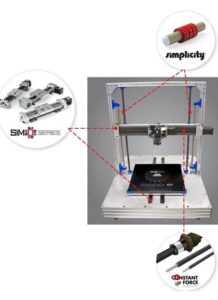Industrial type linear components will be key in low-cost desktop model 3D printers because they can deliver the accuracy and repeatability that users of these units desire. You don’t often hear about the use of linear guides and rails and other components, but these mechanical devices enable printers to deliver ±0.02 mm/m repeatability.
A number of low-cost desktop 3D printers use belt drives for motion to keep the cost down. But the trade-off is lower resolution for a part, giving parts that stair step look you used to see in early professional 3D printers. Increasingly, however, you will start to see low-cost desktop 3D printer developers turning to experienced motion component manufacturers for their X, Y, and Z parts. It is possible to build a low cost 3D printer using parts more commonly found in industrial applications.
One example is the prosumer unit, the Aluminatus TrinityOne from Trinity Labs. This printer uses PBC Linear components.
The Aluminatus TrinityOne, is an open source design. It uses the SIMO Series lead screw driven rails on the X and Y axes and Constant Force Technology (CFT) lead screw and nut to drive the carriage, from PBC Linear. The 3D printer delivers linear motion with a repeatability of ± 0.02 mm/m and a layer height of 50 microns. The parts produced on this printer show a very small stair-step effect. The CFT lead screw allows the drive mechanism to accelerate, brake, and corner fast and precisely.
Those 3D printers that use belt drive technology can hold repeatability to about ±0.1 mm/m and layer height to about 100 microns. Belt technology, though, can result in “springy” motion, which can create parts with moray patterns and a loss of sharpness in holes, cavities, or other object features. So the use of machined components delivers better quality 3D printed parts.
Use of rails and lead screws in the Aluminatus also means this printer is made of fewer components than many 3D printers in this class—35 parts versus several hundred in other units. It takes about 2 hours to assemble. Another benefit is the lead screws let users use the entire 300 X 300 X 350 mm workspace.
The creator of this design, Ezra Zygmuntowicz, CEO, founder at Trinity Labs wanted a simple, easy to build printer, so he chose to work with a company experienced with motion and motion control. Noted Ezra, PBC Linear offers a range of axes, actuators, lead screws and other components, at an affordable price, that fit together in the kit style he wanted, and that take the work out of assuring his printer delivers good resolution and accuracy. This printer currently works with PLA and ABS in multiple colors. As Ezra noted, all the Pantone colors.
PBC Linear
www.PBCLinear.com
Trinity Labs
www.trinitylabs.com



Leave a Reply
You must be logged in to post a comment.